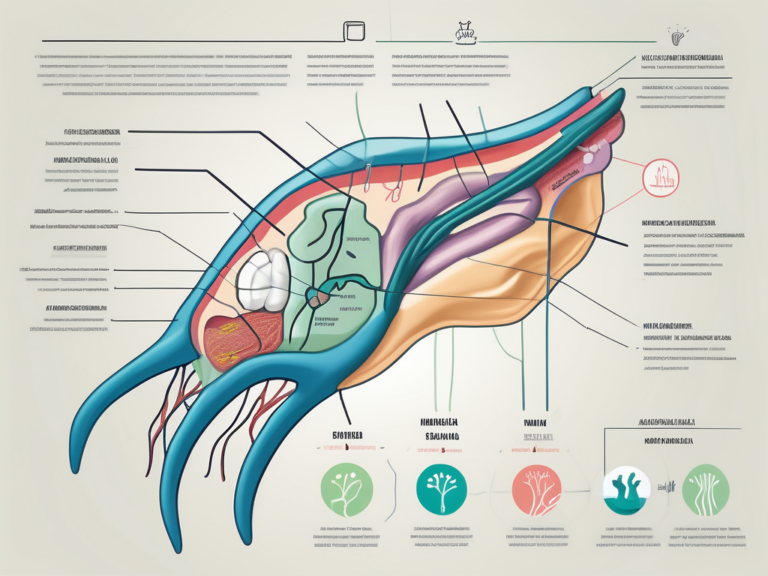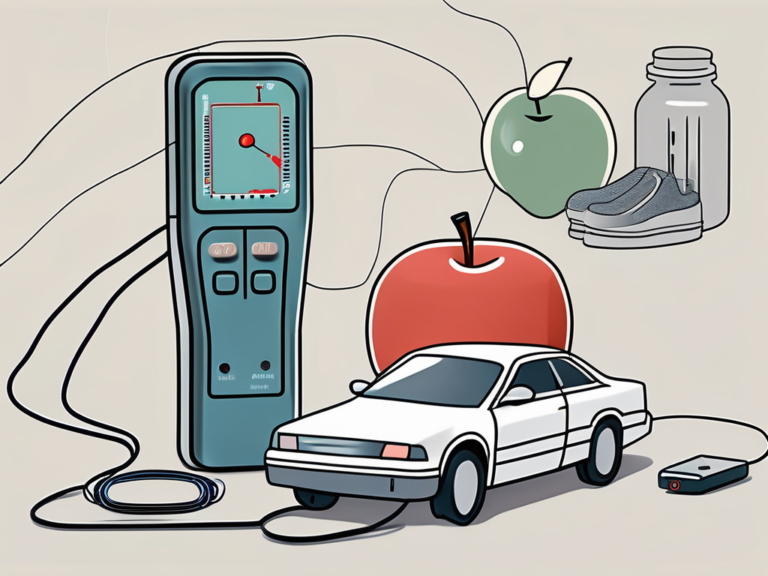Explaining Phrenic Nerve to kids
Dear young readers, today we will embark on an exciting adventure into the realm of the human body to explore a fascinating part of the nervous system called the Phrenic Nerve. So, put on your explorer hats and get ready to learn about this amazing nerve that plays a vital role in our breathing!
Understanding the Basics of the Nervous System
Before diving into the Phrenic Nerve, let’s first understand what the nervous system is all about. Our bodies are like a well-organized team, with each part having a specific job to keep everything running smoothly. Just like a team needs a captain, our body has a team leader known as the nervous system. It controls and coordinates all the actions of our body so that we can move, think, and feel.
When we talk about the nervous system, we’re delving into the intricate network responsible for transmitting signals between different parts of the body. This network is crucial for our survival and functioning, acting as the ultimate communication system that allows us to interact with the world around us.
What is the Nervous System?
The nervous system is made up of billions of tiny cells called neurons, which act as messengers. Imagine them as superheroes that send important information from one part of your body to another at lightning-fast speed! This information helps your body react to things in your surroundings and even helps you make decisions.
Neurons are fascinating cells that come in various shapes and sizes, each playing a unique role in transmitting signals. They work tirelessly to ensure that your body can respond to stimuli, whether it’s feeling the warmth of the sun on your skin or quickly pulling your hand away from a hot stove.
Key Components of the Nervous System
Now that we know what the nervous system is, let’s take a closer look at its key components. The nervous system is divided into two main parts: the central nervous system (CNS) and the peripheral nervous system (PNS). The CNS consists of the brain and spinal cord, while the PNS includes nerves that branch out from the CNS to reach all parts of our body.
The central nervous system, comprising the brain and spinal cord, serves as the command center of the entire nervous system. It processes incoming sensory information, initiates responses, and plays a crucial role in higher cognitive functions such as memory and learning. On the other hand, the peripheral nervous system extends its reach throughout the body, acting as a vast communication network that relays information to and from the CNS.
Introduction to the Phrenic Nerve
Now that we have a solid foundation of knowledge, let’s zoom in on the star of the show – the Phrenic Nerve! The Phrenic Nerve is a special type of nerve that connects the brain with an important muscle called the diaphragm.
The Phrenic Nerve is a fascinating component of the human body’s intricate nervous system. It originates from the cervical spine in the neck and travels through the chest cavity, playing a crucial role in the process of breathing. This nerve is essential for the involuntary function of respiration, ensuring that the diaphragm functions smoothly to facilitate the exchange of oxygen and carbon dioxide in the body.
What is the Phrenic Nerve?
The Phrenic Nerve is like a messenger that carries signals from the brain to the diaphragm. It tells the diaphragm when to contract and when to relax. The diaphragm is a crucial muscle located at the bottom of our lungs, and it plays a major role in helping us breathe.
Furthermore, the Phrenic Nerve is not only responsible for controlling the diaphragm’s movement but also plays a role in regulating other physiological processes, such as influencing the heartbeat and aiding in the transmission of sensory information from the chest and abdominal regions to the brain.
The Role of the Phrenic Nerve in the Body
Now, you might be wondering, “Why is the Phrenic Nerve so important?” Well, let me tell you! The Phrenic Nerve helps us breathe by making our diaphragm move up and down. When we breathe in, the diaphragm contracts and moves downward, allowing our lungs to expand and fill up with air. When we breathe out, the diaphragm relaxes and moves upward, pushing the air out of our lungs.
Additionally, the Phrenic Nerve’s significance extends beyond its role in respiration. It also serves as a vital link between the brain and the respiratory system, playing a crucial part in maintaining the body’s overall homeostasis. Any disruptions or damage to the Phrenic Nerve can lead to respiratory difficulties and impact the body’s ability to function optimally.
The Anatomy of the Phrenic Nerve
Now that you know what the Phrenic Nerve does, let’s explore where it is located and how it is structured!
The Phrenic Nerve is a crucial component of the respiratory system, responsible for controlling the movement of the diaphragm, the primary muscle involved in breathing. Without the Phrenic Nerve, the process of breathing would be impossible, highlighting its vital role in sustaining life.
Where is the Phrenic Nerve Located?
The Phrenic Nerve starts its journey from the base of our brain and travels down through our neck, passing between our lungs and heart, until it reaches the diaphragm. It’s like a bridge connecting two important parts of our body!
As the Phrenic Nerve descends through the body, it also plays a role in providing sensory information to the brain about the state of the lungs and surrounding structures. This feedback loop helps ensure that the respiratory system functions efficiently and responds appropriately to changes in the environment.
How is the Phrenic Nerve Structured?
The Phrenic Nerve is made up of many tiny fibers bundled together. These fibers act like electrical wires, carrying signals back and forth between the brain and diaphragm. Without these signals, our diaphragm wouldn’t know when to move, and we wouldn’t be able to breathe properly.
Furthermore, the Phrenic Nerve is part of the autonomic nervous system, which controls involuntary actions in the body, such as breathing and heart rate. This intricate network of nerves ensures that essential functions continue without conscious effort, allowing us to focus on other tasks while our body maintains its vital processes.
The Functions of the Phrenic Nerve
Now that we understand where the Phrenic Nerve is located and how it is structured, let’s explore its functions in more detail!
The Phrenic Nerve, a major player in the realm of human anatomy, is a crucial component of the respiratory system. Situated in the neck region, specifically between the C3 to C5 vertebrae, this nerve serves as the vital link between the brain and the diaphragm. It is through the Phrenic Nerve that the brain sends signals to the diaphragm, orchestrating the intricate dance of inhalation and exhalation that keeps us alive and well.
The Phrenic Nerve and Breathing
The Phrenic Nerve plays a crucial role in our breathing process. When we inhale, signals from the brain travel through the Phrenic Nerve to the diaphragm, telling it to contract and move downward. This allows our lungs to expand and fill with fresh air. When we exhale, the Phrenic Nerve signals the diaphragm to relax and move upward, helping to push the air out of our lungs.
Furthermore, the Phrenic Nerve is not merely a messenger for breathing; it is a conductor of a symphony of physiological responses. Beyond its fundamental role in respiration, this nerve also influences other bodily functions such as heart rate regulation and even plays a part in the reflex actions that protect our airways from foreign invaders.
Other Functions of the Phrenic Nerve
While the Phrenic Nerve’s primary role is in breathing, it also has some other important functions. It helps us cough, sneeze, and even hiccups! So, the next time you have a pesky hiccups attack, you know whom to blame – the mischievous Phrenic Nerve!
What Happens When the Phrenic Nerve is Damaged?
Just like superheroes can face challenges, the Phrenic Nerve can also encounter some difficulties. Let’s explore what happens if the Phrenic Nerve gets damaged.
The Phrenic Nerve, a crucial player in our respiratory system, originates from the cervical spine and travels down to the diaphragm. This nerve controls the movement of the diaphragm, the primary muscle responsible for our breathing. When the Phrenic Nerve is functioning properly, it allows us to breathe effortlessly, without even having to think about it.
Symptoms of Phrenic Nerve Damage
When the Phrenic Nerve is damaged, it can cause problems with our breathing. We may feel shortness of breath, have difficulty inhaling or exhaling, or even experience weakness in our muscles. In addition to respiratory issues, damage to the Phrenic Nerve can also lead to referred pain in the shoulder or neck region. This nerve plays a vital role in not just our breathing, but also in maintaining the stability of our upper body.
It’s important to remember that if you or someone you know experiences these symptoms, it’s best to seek help from a healthcare professional. Early intervention and proper diagnosis can significantly impact the treatment outcomes for Phrenic Nerve damage.
Treatment Options for Phrenic Nerve Damage
If the Phrenic Nerve is damaged, there are several treatment options available. Medical professionals may recommend therapies, exercises, or even surgery to help restore its proper function. Physical therapy focusing on breathing exercises and diaphragmatic strengthening can be beneficial in improving respiratory function post-Phrenic Nerve injury. Additionally, surgical interventions such as nerve grafting or phrenic nerve pacing may be considered in severe cases to restore breathing function.
Remember, it’s always important to consult with experts when it comes to medical matters. Seeking timely medical advice and following a comprehensive treatment plan can make a significant difference in the recovery process for individuals with Phrenic Nerve damage.
Fun Facts About the Phrenic Nerve
Now that we have covered all the essential information about the Phrenic Nerve, let’s dive into some fun and fascinating facts!
Interesting Discoveries About the Phrenic Nerve
Scientists have made some interesting discoveries about the Phrenic Nerve throughout history. They have studied it to understand how it works, and their findings continue to contribute to our knowledge of the human body.
One fascinating discovery is that the Phrenic Nerve plays a crucial role not only in breathing but also in communicating with the brain. It sends signals that help regulate our respiratory system, ensuring we inhale and exhale properly. This intricate connection between the nerve and the brain showcases the complexity of our physiological processes.
How the Phrenic Nerve is Unique
The Phrenic Nerve is unique because it controls an essential function without us even thinking about it – our breathing! It shows us just how amazing and intricate our bodies are.
Moreover, unlike other nerves in the body, the Phrenic Nerve has a direct impact on our ability to speak. It plays a vital role in controlling the diaphragm, which is essential for producing sound. This dual functionality highlights the versatility and importance of the Phrenic Nerve in our daily lives.
Conclusion: The Importance of the Phrenic Nerve
Dear young readers, now you know why the Phrenic Nerve is such an important part of our bodies. It helps us breathe, cough, and even hiccups! Remember to take care of your body and treat it with respect, as every part plays a vital role in keeping us healthy and happy.
Recap of the Phrenic Nerve’s Role
To recap, the Phrenic Nerve connects our brain to the diaphragm and helps us breathe by controlling its movement. It’s like a superhero messenger that ensures our bodies get the oxygen they need to function properly!
Encouraging Further Learning About the Nervous System
If you’re interested in learning more about the amazing workings of the nervous system, there are plenty of exciting books, videos, and resources available that can take your knowledge to the next level. Remember, always be curious and never stop exploring!
Thank you for joining me on this journey to discover the wonders of the Phrenic Nerve. I hope you enjoyed unraveling the mysteries of our nervous system and understanding how this incredible nerve helps us breathe. Now, take a deep breath and let’s continue our exploration of the incredible human body!






